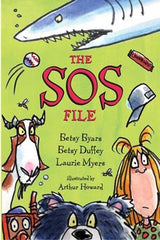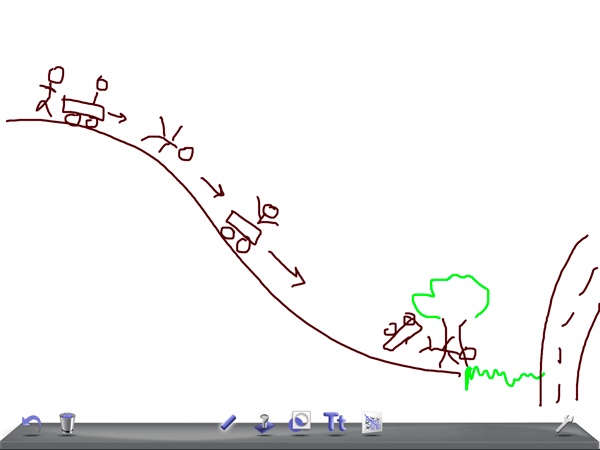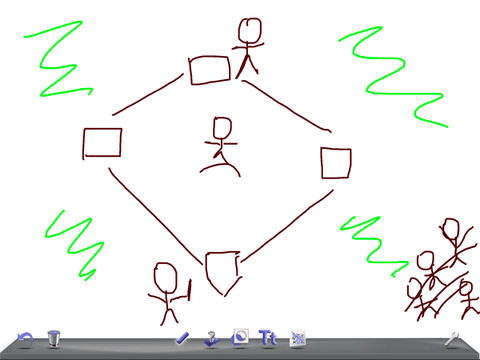Secure Checkout. FREE SHIPPING for Continental U.S. Orders over $60.
Menu
-
- Home
-
About Us
-
The Approach
-
Linking Language & Literacy
-
MindWing Learning
-
Learning Resources
-
SHOP
-
Blog
-
- About MindWing
- Our People
- Contact Us
- Your Account
- Login
-
United States (USD $)

Secure Checkout. FREE SHIPPING for Continental U.S. Orders over $60.
Tech Tuesday: Chapter Books and Stickwriting, a Complementary Visual Strategy
by Sean Sweeney May 17, 2016 4 min read
Using chapter books, which provide richer and yet more difficult narratives older students must tackle, has been a focus of the MindWing Blog this school year. In several of my posts, I have discussed tech-related avenues to getting the context of chapter books your students may be reading in class (to serve as topics for narrative intervention activities with SGM®), as well as apps that can visually represent the Critical Thinking Triangle®, a great support to review the narrative gist of chapters within a book.
 In this post, we are going to take a look at a great chapter book to use along with SGM®, The SOS File by Betsy Byars, Betsy Duffy, and Laurie Myers, along with a strategy that aligns with narrative intervention, Stickwriting, or representing narrative elements through quick sketches. This, in turn, has a tie-in to technology as we will look at an app that provides a great venue for Stickwriting, Doodle Buddy (Apple version / Windows version).
In this post, we are going to take a look at a great chapter book to use along with SGM®, The SOS File by Betsy Byars, Betsy Duffy, and Laurie Myers, along with a strategy that aligns with narrative intervention, Stickwriting, or representing narrative elements through quick sketches. This, in turn, has a tie-in to technology as we will look at an app that provides a great venue for Stickwriting, Doodle Buddy (Apple version / Windows version).
A teacher I was collaborating with introduced me to The SOS File when it served as a read-aloud for her class. We planned several lessons together targeting understanding and use of the narrative elements in the story with SGM®, and I have since re-purposed the book for several other students! The book begins as the classroom teacher, Mr. Magro, issues a writing challenge to his class: for extra credit, students are invited to contribute to the class’ “SOS File” a story about a time “...you needed to call 911, but didn't have a phone!” In other words, a time the students had a problem. When I heard the concept of the book, I instantly thought, “Oh, this book will be full of chapters with different Kick-Offs!”
This proved to be exactly the structure of this fun and engaging book. With each chapter, we learn about the experience, or “SOS,” of a different student, bringing opportunities to analyze their different personality traits and the distinct settings in which their problem occurred. Another feature of the book that I noted was the visual nature of the stories told. First of all, each chapter is accompanied by several line-drawn illustrations by Arthur Howard, great for providing visual supports for students to comprehend the abstract situations in the book. However, my students also benefited from making situational and narrative elements in the chapters more visual through a simple process known as Stickwriting, or sketching the Characters, Setting, situation, or Actions in a story. What a perfect complement for story grammar instruction!
Stickwriting, or pictography—described in detail by Teresa Ukrainetz (1998)—has become one of my go-to strategies for helping students visualize, and therefore comprehend, narrative language (if you don’t have easy access to ASHA journals, the strategy is also described in this resource document). As Ukrainetz describes it, “With pictography, children draft stories by representing characters, settings, and sequences of actions with simple, chronologically organized stick-figure drawings. As a quick and easy representational strategy, pictography can be useful in both individual language intervention and inclusive classroom settings.” Ukrainetz emphasizes the need to help students understand time parameters and keep their drawings “quick and easy,” a factor for which I highly endorse modeling, providing a visual glossary (i.e., stick figures, arrows, word/thought balloons, etc), and use of Ward and Jacobsen’s 360 Thinking Time Tracker app (Apple only) to help students avoid the “time robber” of being too detailed in their drawings.
While Stickwriting can certainly be done with pencil and paper, use of the iPad can add ease to engagement (e.g., many different colors available without the need for markers) , or opportunity to model for an entire class via the use of apps such as Doodle Buddy (free). Open-ended drawing tools such as Doodle Buddy provide an electronic space for use of thin or thick drawing “implements” (e.g., brush or chalk), and the bonus of having a paperless, sharable created resource.
A few examples using the context of The SOS File, along with a Reaction Sequence analysis (though these chapters could be retold as Complete or more Complex Episodes as well):
|

The layout of the hill in relation to the park below, and the busy street beyond it, are important spatial aspects to understanding the Setting and Kick-Off in this chapter. |
|
|
Representing the spatial, causal, and conditional implications of a player being on base during a tied game was important to scaffold the understanding of a student I was working with.
Do note that Doodle Buddy is a one-shot deal—you can only work on one drawing at a time. To work on Stickwriting with multiple groups of students, or over several sessions, you may want to use Book Creator (about $4.99, but free to try for iPad and Android). For students using Google Apps for Education (and for further opportunities to incorporate writing), check out the “scribble” tool in Google Drawings, available on laptops, desktops and Chromebooks.
Sean Sweeney
Sean Sweeney, MS, MEd, CCC-SLP, is a speech-language pathologist and technology specialist working in private practice at the Ely Center in Needham, MA, and as a clinical supervisor at Boston University. He consults with local and national organizations on technology integration in speech and language interventions. His blog, SpeechTechie (www.speechtechie.com), looks at technology “through a language lens.” Contact him at sean@speechtechie.com.
Leave a comment.
Comments will be approved before showing up.

